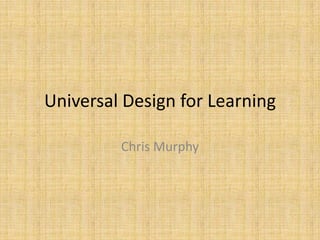App4 murphyc
- 1. Universal Design for Learning Chris Murphy
- 2. The Inspiration for UDLThe inspiration for UDL came from Architects that changed design to help buildings function for all people, disabled or not.
- 3. Inspiration for EducatorsUniversal Design for Learning allows educators to find alternative ways to differentiate instruction.What UDL does for students and teachers:Builds flexibility into the curriculumEndorses 21st Century Skills.Promotes all students to learn.Allows the material to change and not the students.
- 4. 3 Principles of UDLPrinciple 1: To support recognition learning, provide multiple, flexible methods of presentation.Principle 2: To support strategic learning, provide multiple, flexible methods of expression and apprenticeship. Principle 3: To support affective learning, provide multiple, flexible options for engagement.
- 5. Principles of UDLExamples of multiple representations:Verbal description of a chartTactile graphic representation E-text version read by a computer
- 6. Role of TechnologyThe role of technology in UDL has allowed teachers to adapt to the student.Using traditional methods do not provide other ways to look at the problems. Technology offers flexible ways to display the information.
- 7. UDL Impact on StudentsUsing Universal Design for Learning allows for students in the classroom to learn new ways of general educational curriculum through the use of technology.
- 8. Brain Research and UDLNetworks of the BrainRecognition NetworkPattern Processing Strategic Network Processes actions and plansAffective NetworkProcesses emotions; evaluates patterns
- 9. Brain Research and UDLStudents use these 3 networks in different ways and every student is different in processing information. Universal Design for Learning allows to identify the strengths and weaknesses in students.
- 10. ReferencesCenter for Applied Special Technology. (2009). Learning Tools. http://www.cast.org/teachingeverystudent/ideas/tes/chapter4_3.cfmLaureate Education, Inc. (Executive Producer). (2009). Reaching and engaging all learners through technology. Baltimore: Author.










